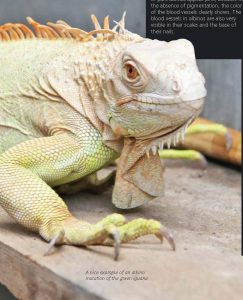A Brief Overview
It was once known as the Iguana iguana iguana. Now, it’s officially the iguana iguana. Confused yet?Yes, it’s an iguana. Technically, it’s a lizard; the green iguana may look like a dinosaur but it’s actually arboreal, preferring to live in forest trees. The higher up you find it, the older it is; they like the sun, are active during the day, and will only come down to burrow for egg-laying. They rarely live far from water, and swim very well.
According to Woodward and Quinn’s “Encyclopedia of Invasive Species,” they were first spotted in the wild in 1966 in Miami, Florida in the year 1966. Green iguanas start out as hatchlings about 9-11 inches in size. Expert keepers caution that while keeping a green iguana as a pet might seem to be easy when they are hatchlings, their care requirements change when they reach the sub adult and adult stages, as does their temperament, especially when they reach breeding age.
Green iguanas can live up to more than 20 years in captivity, though they average only 8 years in the wild. They attain adulthood in three years and can reach up to 5-7 feet in length from nose to tail. This is when the irresponsible keepers abandon them in habitats other than their own. Human introduction of the green iguanas in areas where they are not endemic has threatened local species and their populations.
What’s with the Weird Color?
Albinism is defined in Wikipedia as a “…congenital absence of any pigmentation or coloration in a person, animal, or plant, resulting in white hair and pink eyes in mammals.” This is because such animals lack melanin, which is responsible for an animal’s color. There are two types of albinos: partial and pure. The eyes of pure albinos appear pink, because in the absence of pigmentation, the color of the blood vessels clearly shows. The blood vessels in albinos are also very visible in their scales and the base of their nails.
In green iguanas, the albino mutation is highly sought after and is considered a “designer mutation” by many breeders and hobbyists. Albino green iguanas are pure albinos and there are no records of a partial albino for green iguanas. Albinism is a genetic trait carried on from generation to generation, so partial albino iguanas may eventually exist through selective breeding.

The normal variety of the iguana suits it for its natural environment; other mutations will have difficulty in thriving in the wild because of their color. The color of iguanas is a natural adaptation to their environment; they use this to blend with their surroundings and make it more difficult for predators to spot them at any stage of their life.
That’s why albino iguanas are rarely found in the wild; however, it is not impossible for them to exist in the wild since albino is a recessive gene which can be carried in the DNA of any color of iguana, captive or wild.
Among captive green iguanas, many new mutations have emerged, and are prized as “designer mutations.” These include red, blue or axanthic, pure albino, T-negative albino, hypomelanistic (lime green colored due to pigment reduction), snow, and crimson.
One school of thought among keepers is that albino iguanas have slightly different care needs because their lack of pigment makes them more vulnerable to the effect of UV rays from the sun compared to other iguana colors. But Reptiles Magazine’s Tom Crutchfield states, “Contrary to popular belief, albino green iguanas do well in full sun and with inside ultraviolet light. The sun has no adverse effect whatsoever on the albino iguanas.”
Where are They From?
The green iguana is native to Central and South America, and was introduced to the neighboring islands of Southern Florida and Hawaii. It prefers humid tropical forests, and are the biggest lizards to thrive in these areas.
In their habitat, the adult green iguana uses camouflage to hide from potential predators while the juveniles group together to avoid predators and warn each other of potential threats to the group. This behavior makes them very successful animals as an invasive species (see section below on green iguanas as invasive species).
What They’re Like In Terms of Temperament
The green iguana is often docile as a hatchling, which makes them more appealing as a first reptile pet. This docility can last until adulthood if they are subjected to constant gentle and dedicated human interaction. Some iguana owners fail at this part of caring for the iguana and end up with a very stressed and defensive animal that becomes too much for them to handle.
They prefer to run away than to stand their ground and defend themselves when they encounter threats. However, as adults, the green iguanas can be quite defensive or territorial. Their main defense is their tails. They are able to ward off predators with powerful tail whips that can inflict injuries on the perceived threat; they can be so forceful that sometimes, their tails may break in the process. This is nothing to worry about since the lost tail mostly regenerates over time.
Iguanas are quite intelligent and they are able to learn certain daily routines but once this routine is broken, they may regain their natural wild instincts. Iguanas are herbivores with saw-like teeth and biting is seldom their option for defense; nevertheless, they bite each other when fighting for a mate and to restrain a female during mating.
What They’re Like As Pets
Iguanas are attractive pets since they are mostly active in the day. They are curious, and try to investigate and discover new things around them, especially if something new is added to their enclosure. They will eat while being watched; many iguana keepers even prepare iguana salads for their pets, with chopped mixed fruits and vegetables, topped with reptile vitamins to keep their pets healthy, to observe the way they feed.
This appeared in Animal Scene magazine’s January 2018 issue.






